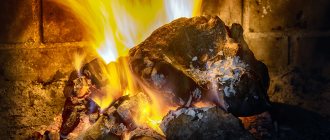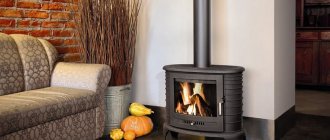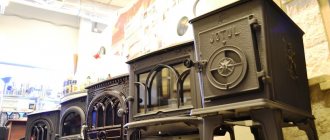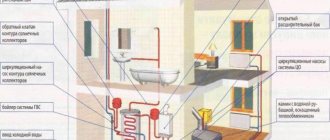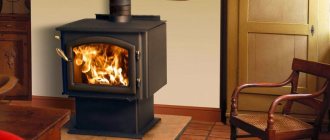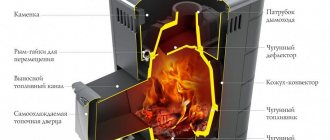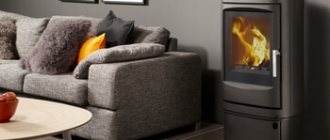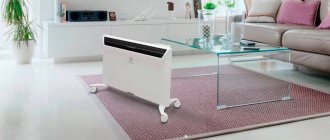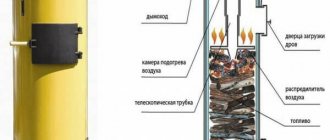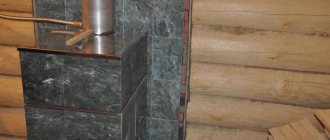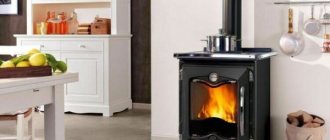Firewood is one of the most affordable types of fuel, which perfectly copes with its tasks - providing comfortable warmth and creating coziness in the room. It is not without reason that many continue to use wood stoves for heating country houses and cottages. This is a beneficial solution for locations with seasonal residence, especially where there is no centralized gas supply. The best wood stoves are economical in fuel consumption, easy to use and have an attractive appearance - even in a small room they do not look bulky. The Garden Assistant online store provides an overview of wood-burning stoves and gives tips on choosing models for your household needs.
Thermal power
Let's start considering the parameters for choosing heating equipment by assessing the thermal power. In an effort to save money, some buyers choose a small, cheap stove, which in practice cannot cope with heating tasks. Its power is not enough to provide heat to a large room. At the same time, a stove that is too large can also create a number of difficulties:
- dry air in the room;
- too high uncomfortable temperature;
- high fuel consumption;
- formation of a large amount of soot and soot.
Important! When assessing the power of the model you like, take into account the dimensions of the room and the likely heat loss - how windy the windows are, whether the attic is insulated, whether the walls freeze.
To calculate power you can use a simple formula:
- Multiply the length of the room with the width and height.
- Divide the resulting number by 14.
This way you will get an indicator in kilowatts that you can use as a guide when purchasing. Keep in mind that some manufacturers indicate its maximum power in the passport for the device, so take a model with a small margin so that its capabilities are enough to heat your home or cottage.
“TOP-model-140” with cast iron door
Characteristics:
- thermal power – 14 kW;
- maximum area of heated premises – 140 m3;
- door type – cast iron, with glass panel;
- chimney diameter – 115 mm;
- weight of the structure – 69 kg.
Price – from 16,260 ₽.
Product link: https://sadpom.ru/products/pech-otopitelnaya-top-model-140-s-chugunnoj-dverkoj/
The rating of wood stoves opens with the TOP model 140, designed for convection heating of buildings. This is a medium-power device that does an excellent job of heating large spaces with a volume of 70 to 140 m3. A rapid increase in temperature is achieved due to hot air flows that heat up inside the oven and exit through special holes in its upper part. The unit can be used in conjunction with a mounted heat sink, which will allow heating adjacent rooms.
Advantages of the model:
- efficient three-turn firebox;
- the ability to heat food on the upper platform;
- increased service life due to a flame arrester made of stainless steel;
- compact dimensions with average power ratings.
Flaws:
- dust entering the air along with air currents;
- Coal and wet wood should not be used for heating.
Back to Contents
Which modern home heating stoves are best suited?
Modern home heating stoves are practical, powerful units that make it possible to create? economical independent heating systems in cottages. The latest technologies for stoves intended for heating a house outside the city recommend many options: stoves stand out by their design, the material from which they are made, the fuel they use, efficiency indicators, etc.
Also, such stoves are safe and do not cause damage to the inhabitants of a country house. But anyone who has a house outside the city limits, first of all, takes care that the materials and technologies used in housing do not cause damage to family members and the external environment.
In this article, let's take a closer look at what stoves for cottages are recommended to us by manufacturers in our time.
Types of modern home heating stoves
Modern home heating stoves, as noted above, are classified according to a wide variety of indicators, but the main ones are the materials from which the stoves are made and fuel. Modern stoves for heating cottages use wood, coal, gas, peat coals and more as fuel.
Based on this, ovens can be:
- gas;
- wood (coal).
But there are many more types depending on the material itself. Modern stoves are made of cast iron, lined with brick or stone (usual stove options) and other materials.
Moreover, stoves come in different thermal conductivities. Three types are emphasized:
- low thermal conductivity;
- medium thermal conductivity furnaces;
- high thermal conductivity.
There are different types of stoves in terms of burning time. Long-burning stoves are used to heat the house. Because of this, we won’t talk about other types this time. Modern long-burning furnaces are equipped with the function of afterburning flue gases. They are also made from a variety of materials, and such stoves can be heated with wood or coal. We recommend taking a closer look at more than ten types of similar stoves and the conditions for their use for heating a house outside the city.
Modern home heating stoves made of cast iron: long burning and afterburning function
Modern home heating stoves made of cast iron, which are classified as long-burning stoves, are often equipped by manufacturers with the additional function of afterburning flue gases. What are the specifics of this function and, in fact, of a very modern cast-iron heating stove at home?
The main feature that should be noted is the fairly high efficiency indicator for stoves of this type. It can reach 70-90 percent.
A similar cast iron stove does not stop working like this: with the required amount of oxygen, the firewood burns very brightly in the combustion chamber; when the oxygen fades, they continue to smolder due to the high temperature. During the combustion of wood, flue gases appear, in other words, which are a mixture of hydrogen, carbon monoxide, methane and other elements. Previously, these gases were a kind of waste; today they are also used for heating. The newest models have an afterburning area, which receives a mixture of a wide variety of elements. This mixture burns there, releasing a considerable amount of heat and increasing the efficiency of the furnace.
The afterburning area can be located either specifically in the combustion chamber of the furnace, or it can be a separate chamber, which is placed above or below the combustion chamber. In order for the flue gases to ignite, additional air enters the chamber, which mixes with the gases and helps them ignite.
What are the advantages of such long-burning stoves? Virtually waste-free, clean work. The firewood in the combustion chamber burns completely, and the flue gases also burn out, releasing additional heat to the house, while no soot or tar is deposited on the internal surfaces of the stove. And most importantly, combustion products enter the atmosphere in very small, non-hazardous quantities.
Long-burning furnaces that have an afterburning function can be made not only from cast iron. Steel stoves are used everywhere, fireplaces with similar functions, masonry stoves, etc. are installed. Let us recall that most stoves of this type are classified as units of small heat capacity, which, in most cases, are used for domestic heating.
Long-burning cast iron stoves are available in a variety of sizes: there are models designed to create independent heating systems, and there are small options that are suitable for heating individual rooms in a cottage. Small stoves also have a good efficiency rate - in the range of 80-84 percent.
In most cases, such stoves are installed in houses where heating may be useful infrequently and for a short time (for example, in a summer cottage on a rainy and cold day). In cottages that are widely used in winter, such stoves can only be installed as an additional heat source.
The dimensions of cast iron stoves affect their power. In general, manufacturers produce models with a power in the range of 3-17 kW, while stoves with low power are usually installed in small rooms, and powerful stoves (15-17 kW) are suitable for heating a one-story country house containing an area of no more than 150 square meters.
In order for the stove to heat all the living spaces in the house, you need to equip a heat distribution system (heating system) and with its help it will deliver heat to all rooms of the country house. For such a distribution system, specialized ventilation channels and grilles can be used that allow warm air to pass through. Fans help distribute it throughout the house.
Cast iron stoves with an afterburning function are not considered a great solution for creating an individual heating system, since the air heated by the stove may cool down before it reaches all rooms of the house. Because of this, experts advise using a specialized cast iron heating stove.
All long-burning cast iron stoves use solid fuel, but not very nutritious. Firewood with a moisture content of 15-20 percent is suitable for this, and, infrequently, brown coal, and also peat coal.
Heat transfer in such furnaces is carried out using heat radiation and convection. The latter is organized using specialized channels into which air is supplied, then it is heated and released into the room through the provided grilles.
Most modern cast iron stoves have fireproof glass doors. This characteristic allows you to monitor the burning flame. Some models may also have hobs or niches for preparing food, this makes them universal units.
An important advantage of these stoves, in addition to being environmentally friendly, is the rapid heating of the room. They can heat up the air in a small room in half an hour. This characteristic makes them more popular when compared with conventional stoves, which need to be lit in advance to heat the room. On the other hand, the surfaces of such ovens become very hot, so they must be handled very carefully.
Modern home heating stoves made of soapstone are classified as long-burning heat-accumulating units that have an afterburning function. These modern soapstone stoves are highly efficient for heating a home outside the city. Their efficiency is 88-90 percent. Stoves made of this material have a large heat capacity and can heat several rooms quickly and efficiently. For equipping an individual heating system in a cottage, the use of such stoves is an excellent option.
The characteristic of this type of stove is that they can collect heat and, over time, smoothly and fairly uniformly release it into the room. This became possible thanks to soapstone, which has a heat capacity 2.5-3 times greater than that of brick.
Moreover, this characteristic, among other things, makes it possible not to worry about firewood. They can be added no more than 1-2 times during the day.
Soapstone furnaces are very bulky and can weigh several centners, or even tons. Very often, such stoves have fireplace doors with heat-resistant glass (quartz), which does not smoke thanks to specially organized airflow.
Such stoves can be lined to suit any interior; the lining can, for example, simulate a classic Russian stove and more.
These stoves are heated with wood, brown coal, peat coal, etc. The combustion space of soapstone stoves tolerates high temperatures well. The exclusivity of this stove lies in the fact that, if desired, it can be supplemented with tubular-type heating elements powered by electricity, which will maintain the temperature in the cottage even during the absence of the owners.
Soapstone stoves are not dangerous from an environmental point of view: like cast iron stoves of this type, they do not emit gaseous, liquid or solid substances into the atmosphere. Moreover, the stove surfaces heat up to no more than 70 degrees. These units also protect the air humidity in the room within the range of 30-60 percent. Models are produced that have ovens for cooking food, so this modern oven will make it possible to completely replace an ordinary Russian oven. The disadvantages of this stove include thermal inertia: the stove takes a long time to heat up - up to 2 hours. Moreover, it can only be installed after installing a specialized foundation for the furnace, and, of course, it is not recommended to install it on the second floor.
Long burning mode
The best heating stoves are designed in such a way as to retain heat for as long as possible and prevent rapid combustion of fuel. When purchasing, make a choice in favor of pyrolysis devices with a long-burning option - they are equipped with an additional firebox for burning the gas emitted by wood. This design slows down the process of fuel burnout, which allows you to maintain a comfortable room temperature for up to 8 hours on one stack of firewood. Such modifications differ from conventional furnaces in the metered supply of oxygen in the upper part of the body.
A stove with pyrolysis mode will be an excellent solution for heating at night. It is enough to prepare a pile of firewood in the evening to keep the house warm until the morning.
Long-burning furnace "Matrix-200"
Specifications:
- maximum power – 20 kW;
- volume of heated room – 200 m3;
- door type – steel with heat-resistant glass;
- chimney diameter – 115 mm;
- net weight – 74 kg.
Cost – from 18,690 ₽.
Link to the product:
The Matrix wood stove perfectly combines modern design and time-tested technical solutions. The model supports a long burning mode for up to 8 hours due to a multi-turn firebox and dosed air supply for combustion of residual gases. The device is suitable for heating country houses, large workshops, garages, outbuildings, and the design allows the chimney to be routed in a convenient direction - up or back.
Pros:
- recessed design – saves space and expands installation possibilities;
- convector casing – responsible for fast, uniform heating;
- presence of a panel for heating food.
Flaws:
- requires a lot of draft to effectively remove combustion products;
- increased soot formation.
Back to Contents
How to increase efficiency
Brick structures are heavy and cannot be placed on the second floor
In order to increase this indicator of a wood-burning stove in the house with your own hands, it is necessary to increase the size of the fuel compartment, make it more spacious and capacious. At the same time, the depth of this element should remain minimal.
Advice: in order to increase the efficiency of the heating unit, the walls of the combustion part expand towards the room or cause them to collapse slightly. Also, the combustion compartment may have double walls or an air cushion. Most ready-made models have an efficiency of at least 75 percent, which allows you to buy a ready-made heating device without resorting to lengthy and complex DIY work.
Increasing the efficiency of a stove with a hob
In order to increase the efficiency of this type of heating installation, you may have to additionally equip your existing chimney system with steel pipes, which you must install yourself in the chimney compartment. Thus, you will receive additional thermal energy by heating these pipes (air or water in them).
In order to increase efficiency and efficiency, the fireplace must be hermetically sealed with a door
Important: in order to evenly distribute the thermal energy generated by a small cast-iron or steel fireplace throughout the room, we recommend installing a special exhaust mechanism.
Also, the blower, which needs to be slightly altered, can add additional efficiency. In particular, you will need to install a pipe with a damper into it. Thus, heated air masses will move more slowly and warm up to a greater extent.
Availability of a hob
If a stove is purchased for a suburban area, the presence of a cooking panel will be a huge plus. A device of this type allows you to solve three problems at once - create a comfortable microclimate in the room, provide a lot of heat for preparing simple dishes and maintain the temperature of the prepared food for a long time.
Important! Depending on the design of the upper part of the boiler, the user can cook food over an open flame or on a special surface that imitates a hob.
Ovens with a hob are created using a special design that does not allow heat to dissipate, but concentrates it near the surface of the stove. Another important point is that the furnace casing itself should not get too hot so as not to cause burns. To adjust the heating power, the design includes metal rings - by removing them, you can change the diameter of the hole for supplying the flame, thereby decreasing or increasing the temperature.
Most often, manufacturers use cast iron and steel alloys to make hobs. Cast iron stoves are heavy, but they last a very long time. If you are looking for lighter, more compact designs, choose units made from steel.
“Pechurka +” with cauldron function
Characteristics:
- maximum power – 5 kW;
- room dimensions – 50 m3;
- type of construction – floor;
- hob – cast iron with cauldron rings;
- door – steel;
- connection to the chimney – rear;
- product weight – 29 kg.
The cost of equipment is from 7,860 ₽.
Link to the product:
The rating of wood-burning stoves for summer cottages includes this compact, ergonomic model, which is ideal for small spaces - garages, outbuildings, garden houses. The body, made of steel, is equipped with a cast iron hob with rings in the upper part. The stove easily turns into an open hearth for installing a cauldron - to do this, just remove the removable rings. “Pechurka” will help you easily prepare your favorite dish, providing food for even a large company.
Advantages:
- combination of stove and hearth for a cauldron;
- protects against infrared radiation thanks to a decorative convector casing;
- takes up little space;
- Convenient to transport.
Disadvantages of the model:
- not suitable for large rooms;
- only one connection option to the chimney.
Heating and cooking stove "GreyVari 100"
Specifications:
- thermal power – 10 kW;
- maximum volume of heated area – 100 m3;
- hob – yes;
- burner diameter – 154 mm;
- type of connection to the chimney – top;
- structure weight – 43 kg.
Price – from 9,610 ₽.
Product link: https://sadpom.ru/products/pech-otopitelno-varochnaya-grejvari-100/
The installation is designed specifically for air heating of premises whose total volume does not exceed 100 cubic meters. At the top of the oven there is a cooking surface on which you can simultaneously place several containers for cooking. The back wall is reliably protected from overheating by an aerodynamic nozzle, and the directed flame flow allows you to create the optimal temperature for cooking. The complex shape of the firebox increases the heating area, and combustion efficiency increases due to the secondary supply of air to the afterburning zone.
Pros:
- high efficiency values;
- there is a panel for cooking;
- warms up quickly;
- Keeps warm for a long time.
Flaws:
- low power;
- The efficiency of work directly depends on the quality of the installation.
Back to Contents
How to choose and what to pay attention to?
When choosing a long-burning fireplace stove, you should pay close attention to the following circumstances:
- Availability of fuel and its cost . If there are accessible sawmills or other sources of carpentry waste near your place of residence, you should pay attention to models that burn wood. If coal or peat resources are available, stoves designed to consume this type of fuel will be suitable.
- Material used for the production of the case . This factor will significantly affect both the price of the fireplace stove and the heat transfer performance. In addition, the service life of the entire structure largely depends on the quality of the housing. The body can be made of steel, ceramic material or cast iron. The last option is considered the most optimal.
- Power characteristics . They are selected depending on the area that needs to be heated in the ratio of 1000 W for every 10 m2 (with a ceiling height of 2.5 to 2.8 m) + 15-20%.
- Weight . The weight of a cast iron fireplace stove will exceed that of a steel product by about 1/5. If the house has already been renovated and the site for installing the stove has not been reinforced in advance, you should choose a steel product.
Furnace design
Modern manufacturers are gradually abandoning bulky structures in favor of compact, energy-efficient models with a stylish design. Since wood stoves are most often used to heat one or two adjacent rooms, it makes no sense for buyers to purchase massive units that will only clutter the room.
If you don’t know which heating stove is best to choose for your living space, take a look at modern models stylized as a wood-burning fireplace, with transparent doors through which you can admire the open fire. Units with forged elements that fit perfectly into a classic country interior are popular.
Important! To light a fire in the fireplace faster, store the wood in a dry place or place it in a special firewood box to dry in advance.
Wood burning fireplace "Tango"
Characteristics:
- heated room volume – 80 m3;
- door material – heat-resistant glass with a visible diagonal of 500 mm;
- chimney diameter – 150 mm;
- smoke exhaust type – rear;
- device weight – 91 kg.
The cost of the model is from 27,810 ₽.
Link to the product:
The rating of heating stoves is completed by an elegant wood-burning fireplace with a glass door. Inserts made of stainless mirror steel create interesting highlights, captivating with the beauty of the flame and giving the design visual lightness. The large diagonal of the glass door allows you to admire the flames and create a cozy atmosphere in the house. The design includes a compartment for storing and drying firewood and a firebox protection system - vermiculite slabs.
Advantages:
- spectacular appearance;
- does not require a foundation for installation;
- compact design;
- effectively copes with heating tasks;
- There is a built-in stove for heating and cooking.
Flaws:
- relatively high price;
- not suitable for heating large rooms.
Back to Contents
Wood stove for heating a private house: analyze and choose
Wood stoves for heating a private home are no less (and in some regions even more) in demand than at the beginning of the last century. Most often, the “fault” of such popularity is the availability of fuel and the attractive cost of the heat generator itself. In addition, we should not forget about “forced popularity”, when connecting to a gas pipe is impossible, and storing other types of fuel (coal, diesel fuel, gas in cylinders) is quite troublesome.
The Russian market of climate control equipment offers a variety of models of modern wood-burning stoves for heating a home, cottage or small technical premises. The types, design features and selection criteria for this equipment will be discussed in this publication.
What does the domestic market offer?
Despite the abundance of types and varieties of wood-burning heating devices, they all have a common principle of operation: obtaining heat from the combustion of wood or wood waste. Depending on the design features of the device, thermal energy is used to heat the air or the built-in “water jacket” for the radiator heating system. The second option is most often used for heating large country houses or industrial premises, the first is for heating small private and country houses, garages, etc. Almost every line of these products has models with a built-in hob. If desired, you can also find a wood-burning stove with a boiler for heating the house and creating hot water supply in it.
This equipment differs:
- Heat transfer power, which must be selected based on the volume of the heated room.
- Body shape. As a rule, most manufacturers produce stoves of a traditional rectangular or cylinder shape. For small rooms, our compatriots prefer to purchase corner heat generators.
- Case material. The specificity of the operation of these heating devices is such that steel or cast iron is used for the production of wood-burning stoves. You can build a fireplace stove to heat a house made of brick or natural stone, but this decision is associated with many difficulties, among which the main ones are time costs and serious financial investments in the material and the work of a stove specialist.
There is another important difference between wood-burning stoves presented on the domestic market - this is the design of the boiler unit, which affects the principle of fuel combustion, power, efficiency and other characteristics.
Single chamber, direct combustion
Such heating devices have the simplest design of a combustion chamber with a grate at the bottom, under which there is an ash pan. These stoves are (in common parlance) called “stoves”. The operating principle of these devices is as follows: when wood burns, the body heats up, which becomes a source of infrared radiation. Single-chamber furnaces do not require automation or additional air pressure.
Advantages: simplicity of design, energy independence, affordable cost.
Disadvantages: High maintenance requirements. Low efficiency (35-45%).
Important! Since the main source of heat in single-chamber furnaces is the body, there is a high fire hazard and the likelihood of injury (burns) due to careless operation.
Convection
Heating boilers of this design, as in the first version, have one combustion chamber. To increase the efficiency and eliminate the main problems, manufacturers equip the equipment with air channels that pass between the firebox and the casing of the device. In cheaper models, the channels are made in the form of gratings in the upper and lower parts of the boiler installation; in more expensive ones, this is a whole set of pipe sections recessed into the combustion chamber.
Heating of the room occurs due to convection: the air in the pipes heats up and leaves the upper pipes. Its place in the air channels is taken by colder air, which (according to the laws of physics) is located in the lower part of the heated room.
Convection stoves for heating a house using wood heat the room quickly enough, while their surface remains practically cold.
Tip: If you connect air ducts to the top of some air ducts, then such a stove can even heat several adjacent rooms in the house.
Hydrolytic
This type of heat generator uses the principle of high-temperature combustion of organic matter in an oxygen-depleted environment. In this case, the furnace receives thermal energy from two sources: during the combustion of fuel and pyrolysis (hydrolysis) gas, which is discharged into a separate chamber, where it is burned out. Air is supplied to the afterburning chamber using an inflatable fan. This type of heating equipment is usually equipped with automation that controls all fuel combustion processes.
This design has a number of advantages:
- High efficiency (up to 90%)
- Environmentally friendly.
But the main advantage of hydrolysis boilers is the reduced frequency of maintenance due to the increased burning time of wood and a tiny amount of dry residue (ash).
Disadvantages: Possible formation of condensate (at insufficient temperature of exhaust gases), high cost, requirements for fuel moisture, volatility.
Heat generators powered by wood waste
All woodworking waste, which is used as fuel for these heat generators, is compressed in the form of small granules, which allows them to be burned using a special burner. Fuel is supplied to the burner automatically, using a screw mechanism or a pneumatic pump.
Such wood-burning stoves are rarely used for heating homes due to their rather large dimensions. The design of the heat generator is single-chamber. The air in the room is heated by direct heat transfer from the surface of the furnace or by heating the heat exchanger with coolant circulating through the heating system.
The main advantage of this type of boiler equipment is long-term autonomous operation without human intervention.
Disadvantages: Volatility dependence, the presence of a separate room for storing fuel, high cost of equipment.
Where to install a wood heating boiler?
When purchasing a wood stove to heat your home, you should understand that the operation of such equipment involves open fire and the release of toxic combustion products. That is why the main requirement for the installation of heat generators is fire safety, the presence of a functioning ventilation system and chimney in the heated room.
- In a wooden house, the distance from the wall to the boiler installation must be at least 1 m. When finishing the walls with a fire-resistant plaster mixture or installing a heat-reflecting screen, the distance from the boiler to the wall can be reduced to 0.8 m.
- As a base, it is necessary to use a fireproof stand that protrudes beyond the perimeter of the heat generator by at least 300 mm.
And as a conclusion: Proper installation of a wood-burning stove requires certain knowledge and experience. We strongly recommend that all procedures related to the installation of heating equipment and the organization of a smoke removal system be entrusted to professionals.
ventilationpro.ru
Additional selection criteria
To avoid making a mistake when choosing a wood stove model, evaluate the following factors:
- how much space are you willing to allocate for installing a heating system;
- how often will you use the unit;
- Do you plan to cook on the stove?
- where and how you can install the chimney.
Additional options also include:
- Body and firebox material. The best reviews are received by models made of high-alloy heat-resistant steel or cast iron. They are durable, hold heat well and do not burn out.
- Economical. Make a choice in favor of devices with high efficiency rates, long-burning modes and sealed doors that prevent heat loss.
- Dimensions. Selected in accordance with the room in which the stove is planned to be installed. The stove should not take up much space and create discomfort for people in the building. This parameter is especially important in small country houses, where every centimeter counts.
- Safety. A good stove should provide a lot of heat to the room, but at the same time protect the body from overheating and the user from accidental burns. The permissible heating temperature of the housing surface should not exceed 90-95 °C.
- Volume of the combustion chamber. A large firebox can accommodate a large amount of firewood at once, which frees the user from the need to constantly load fuel. In addition, a small chamber in practice turns out to be inconvenient when working with large logs.
- Connection to the chimney. The best choice would be a universal option for removing combustion products, when the pipe can be connected in several ways - from behind, from above, from the side. If there is no such choice, evaluate in advance the features of the chimney system in your home so that the selected stove can be easily connected to it.
Choosing a wood-burning stove will not be a difficult task if you think through all the installation nuances in advance and assess your own needs for certain functions.
The largest, expensive model will not always be a good solution, especially if the room is small or rarely used. Select power and design so that the climate is comfortable with low fuel consumption. Return to list of articles
Long-burning wood-burning stoves for the home with high efficiency
The widespread development of the construction of private residential houses in our time has caused a radical change in the heating means and structures used in this sector. Not so long ago, a wood-burning stove in a home seemed like an anachronistic relic of the past, and a fireplace and fireplace stove were considered more of an interior item than a radiator.
A stove made by a famous stove maker, a fireplace made by a famous master, although they were considered an object of pride, were rarely used for their intended purpose. Today, industry, both large and ours, offers a wide range of utilitarian approaches to the design, installation and arrangement of wood-fired heating in homes, which allow us to consider this type of heat supply for heating residential premises not only quite modern and good, but also quite practical.
Home heating stoves are mainly wood-burning pyrolysis appliances with a high efficiency factor (efficiency indicator). According to their design, the models are very different; naturally, the practical characteristics and their applicability for heating certain rooms also differ.
Residential heating stoves can be divided into more than ten types according to their design features:
- Long-burning furnaces with a hydraulic circuit;
- Long-burning cast iron stoves;
- Long burning cooking stove;
- Cooking ovens with stove;
- Tube furnaces;
- Stoves-fireplaces;
- Long burning fireplace.
Ready-made listed designs can be selected at retail. Any wood stove option has its own pros and cons. Below we will consider some of their most popular designs.
Installation and operation specifics
Modern heating stoves do not require a specialized foundation, as they are made primarily from specialized alloys. There are also stainless steel stoves. The combustion chambers are made of fireproof metal or cast iron structures. The operation of stoves requires their correct installation from a fire safety point of view.
To do this, it is necessary to follow the installation rules for the combustion chamber, smoke exhaust and heated parts in relation to walls and other objects. The installation diagram should also provide equal air convection in the room, the ability to comfortably close and open the burning combustion chamber of the stove if necessary.
Combustion of wood in a home stove or stove for cooking is a rather long and quite economical process, thanks to which sufficiently high spaces for storing firewood are not required. Long-burning wood burning systems for the home often also have stoves (electric stoves).
Their installation scheme must take into account the use of the slab for its intended purpose with the corresponding requirements and restrictions. The installation of the stove must take into account reliable protection against movement.
How to choose the right one
In order to choose the right stove for your home, stove or fireplace, it is appropriate to determine its practical purpose and how many purposes it would be nice to combine simultaneously with heat supply. The stove heats the air in the room, however, if it is also used for other purposes, this can be comfortable, but if you don’t need to heat, but you need a stove, this situation is not very comfortable.
Using the most inexpensive stove heat supply option to heat only to heat the room during cold weather is usually a relatively cheap type of heat supply. On the other hand, using the stove surface for cooking, if you cook a lot during the cold season, is also an impressive reduction in costs for other energy sources.
Today on the Internet you can also find drawings of a long-burning wood-burning stove, but this is no longer very important, since industry and retail actually provide a wide selection of different options, and making a metal combustion chamber of a stove or stove on your own is very difficult and, in general, not an inexpensive task.
Selecting a bright stove for your home is not a very common task, but it can be made easier by dividing it into three related areas:
- Practicality - only heat supply or Plus, the functions of cooking, water heating, temporary local heating, artistic functions (stoves-fireplaces) are needed;
- The volume of the heated room - this is also due to the supposed limitations of practicality; also, with large heating areas, it may be better to divide them into several radiators and, based on this, divide their practicality;
- Installation location, heating scheme - sometimes the choice is determined by the geometry of the space available in the installation room.
Based on these nuances, you can select a specific model, depending on its operational capabilities and technical parameters.
Advantages and disadvantages
The advantages of long-burning wood burning models for the home are clear. There is no need to heat it 24 hours a day. One loaded combustion chamber of the furnace will burn for 8-10 hours. The main disadvantage of operating furnaces of this type, surprisingly, is their high efficiency. The thing is that the flue gases at the outlet, giving off their own energy, have a very low outlet temperature (130 - 180 C). Thereby:
- In such long-burning devices, the draft is much less;
- A lot of condensing substances (water, resins, soot) are formed in the pipe, and if the chimney is installed incorrectly, this can lead to frequent blockages.
The listed problems have been technically solved over more than 20 years of experience in the widespread use of such heating technologies. Standard pipes and chimneys are produced by manufacturers, installation diagrams are described in manuals, and the stated passport parameters from bona fide suppliers correspond to reality.
How to calculate power
To calculate the required power, it is enough to know the volume of the room and its area, however, you need to keep in mind that the typical values in the technical data of radiators are calculated for the normalized heat transfer values of walls, ceilings and roofs. If your house does not have sufficient thermal insulation, the power should therefore be greater.
Information on power and recommended parameters for the heating area can be found in the product data sheet. The most common way to determine the required power is through sanitation standards: 100 W/hour per 1 m2 of room (with a typical height of 2.7 m). More complex calculations include heat transfer from the walls and the number of windows.
Rating of long burning stoves
Looking at the variety of parameters in technical terms and the quality/cost ratio, it is necessary to highlight some manufacturers present on the market. Among domestic companies, it is necessary to highlight Teplodar furnaces.
This is a fairly reliable product, distinguished by its thoughtful design and execution. Among foreign manufacturers, we can recommend Finnish stoves, as well as products of the Canadian company Buleryan and its joint ventures. The list of recommended manufacturers on the market looks like this:
To summarize in great detail about the products of the listed companies with a short description of the furnaces that they recommend.
Teplodar stoves are available in several types. Quite ordinary, but durable designs provided on the market have already been tested by consumers. In the category of ordinary and cheap products, you can really choose a suitable model without any practical frills.
Pros: structural simplicity, cost.
Cons: few universal options, simple design, efficiency less than premium designs.
Thermofor stoves have several lines, very different in variation, power and practical features. Termofor is a Siberian company, they know very well how important it is to provide home heat. Models of stoves for heating with wood are distinguished by their ultra-modern and representative design, the application of best practices, and the use of the latest developments.
Termofor also makes models with a water heating section. There are also conventional options - for example, an analogue of Buleryan, but with additional deflectors that significantly improve air convection and appearance. All Termofor units are equipped with a well-thought-out heat transfer system and excellent quality metal products.
Pros: variety of models, high quality, high efficiency, good adjustability.
Cons: relatively high cost.
Ermak products can also be classified as cheap. They stand out for their somewhat non-standard design, which fits into today’s interior style. They are equipped with both steel and glass doors. You can find models with water heat exchangers. In their own price category they look quite nice.
Pros: cost, durability, availability of models with different functions
Cons: the quality is worse than in the premium segment, the design is not very modern, efficiency and adjustability are lower than in premium ones.
Finnish stoves
Finnish manufacturers have long been ahead in the bath products market. Finnish wood-burning sauna stoves have probably been met by everyone. They have also mastered the section of metal heating systems for houses. Finnish products are distinguished by their comparative simplicity and reliability of both the firebox part and the doors.
Basically, the models do not contain the entire range of new products offered by other manufacturers, but there are all solutions that have been well tested by time. Finnish products are always of high durability and quality, but at the moment they are quite expensive when compared with domestic competitors.
Pros: workmanship, durability, relatively high efficiency.
Cons: price, lack of modern technical innovations.
Essentially, this company from Canada was the first to enter the market with mass production of long-burning wood stoves. The first stove from the Buleryan company is more than 20 years old. And all this time they work quite flawlessly. Since then, little has changed in both design and financial execution.
In the position of the first manufacturer, the company evokes legitimate respect, the technologies used are reliable and proven by experience, however, the design and the lack of use of more solutions of our time raises many questions.
Pros: greater reliability, durability, fairly high efficiency.
Cons: design, lack of modern solutions.
